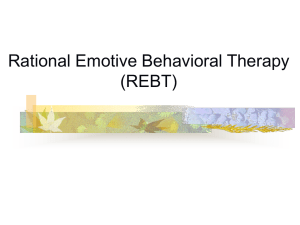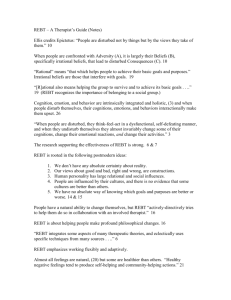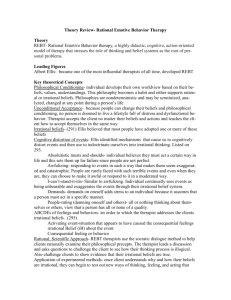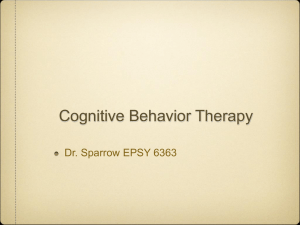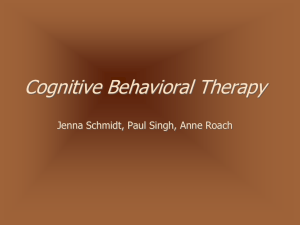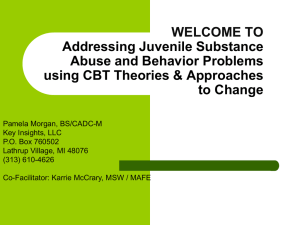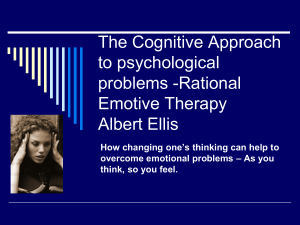REBT & CBT: Rational-Emotive & Cognitive-Behavior Therapy
advertisement
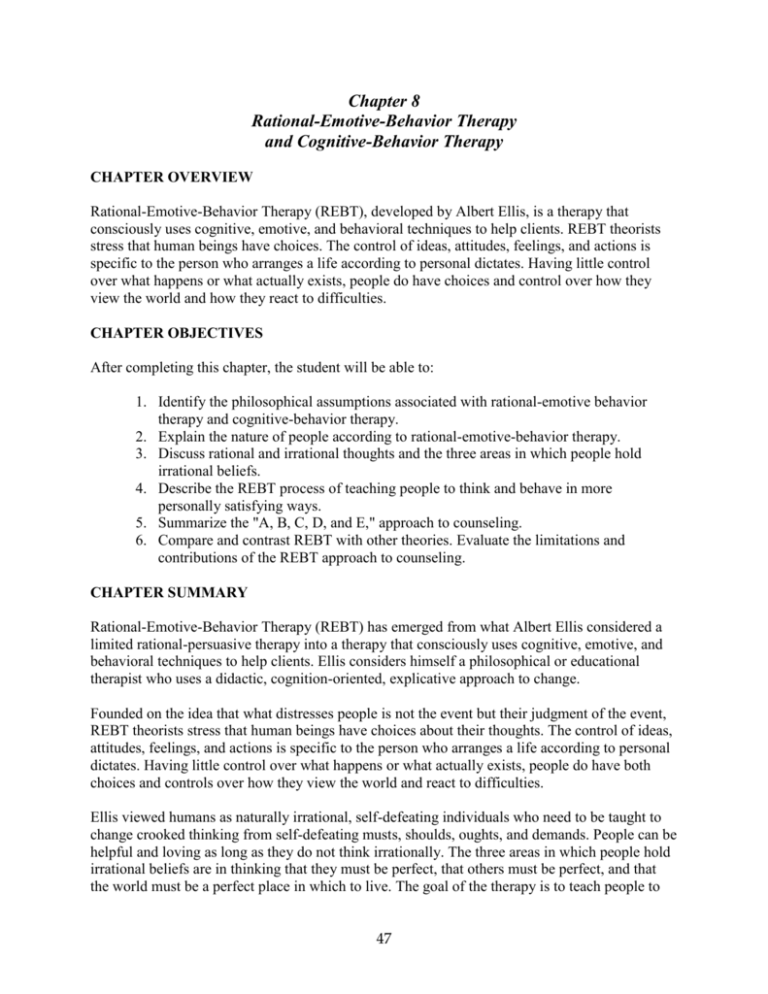
Chapter 8 Rational-Emotive-Behavior Therapy and Cognitive-Behavior Therapy CHAPTER OVERVIEW Rational-Emotive-Behavior Therapy (REBT), developed by Albert Ellis, is a therapy that consciously uses cognitive, emotive, and behavioral techniques to help clients. REBT theorists stress that human beings have choices. The control of ideas, attitudes, feelings, and actions is specific to the person who arranges a life according to personal dictates. Having little control over what happens or what actually exists, people do have choices and control over how they view the world and how they react to difficulties. CHAPTER OBJECTIVES After completing this chapter, the student will be able to: 1. Identify the philosophical assumptions associated with rational-emotive behavior therapy and cognitive-behavior therapy. 2. Explain the nature of people according to rational-emotive-behavior therapy. 3. Discuss rational and irrational thoughts and the three areas in which people hold irrational beliefs. 4. Describe the REBT process of teaching people to think and behave in more personally satisfying ways. 5. Summarize the "A, B, C, D, and E," approach to counseling. 6. Compare and contrast REBT with other theories. Evaluate the limitations and contributions of the REBT approach to counseling. CHAPTER SUMMARY Rational-Emotive-Behavior Therapy (REBT) has emerged from what Albert Ellis considered a limited rational-persuasive therapy into a therapy that consciously uses cognitive, emotive, and behavioral techniques to help clients. Ellis considers himself a philosophical or educational therapist who uses a didactic, cognition-oriented, explicative approach to change. Founded on the idea that what distresses people is not the event but their judgment of the event, REBT theorists stress that human beings have choices about their thoughts. The control of ideas, attitudes, feelings, and actions is specific to the person who arranges a life according to personal dictates. Having little control over what happens or what actually exists, people do have both choices and controls over how they view the world and react to difficulties. Ellis viewed humans as naturally irrational, self-defeating individuals who need to be taught to change crooked thinking from self-defeating musts, shoulds, oughts, and demands. People can be helpful and loving as long as they do not think irrationally. The three areas in which people hold irrational beliefs are in thinking that they must be perfect, that others must be perfect, and that the world must be a perfect place in which to live. The goal of the therapy is to teach people to 47 think and behave in a more personally satisfying way by making them realize they have a choice between self-defeating, negative behavior and thought and a more efficient, enhancing, positive behavior. This is accomplished by teaching people to take responsibility for their own logical thinking and the consequences or behaviors that follow it. Ellis theorized that a belief system - what people tell themselves about an event - determines responses or feelings toward that event. People naturally and easily think crookedly, express emotions inappropriately and behave in a self-defeating manner. REBT teaches how to do otherwise. Irrational beliefs cause trouble. Lists of common irrational beliefs that lead to negative emotions and stress in children, adolescents, and parents are included in the chapter. Irrationals beliefs can form a chain of further irrational beliefs. The categories of those thoughts are self-defeating beliefs, highly rigid and dogmatic beliefs, antisocial beliefs, unrealistic beliefs and contradictory beliefs. The goal of REBT is to teach people to think and behave in a more personally satisfying way by making them realize they have a choice between self-defeating, negative behavior and efficient, enhancing, positive behavior. The first objective of therapy is to show a person how irrational beliefs or attitudes create dysfunctional consequences such as anger, depression, or anxiety. The second objective is to teach the client how to dispute or crumble the irrational beliefs and replace them with rational thoughts. This will allow the client to escape the cycle of negative feelings and be free to choose behaviors that eliminate the problem or the disappointing impact of the problem. "A, B, C, D, and E" refer to these ideas. A is the activating event. B is the person's reaction to the event. C represents the consequences or feelings resulting from the person's evaluation of the activating event. D represents the disputing arguments that can be used to attack the irrational self-messages included in the evaluation of the activating event. E is the answers given to the questions raised in D. REBT is direct, didactic, confrontational and verbally active counseling. Several factors help counselors detect irrational thinking. They can look for overgeneralizations, distortions, deletions, catastrophizing, absolutes, condemning and fortune-telling. Once the irrational beliefs are recognized, the counselor disputes and challenges them. Ultimately the goal is for young people to recognize their irrational beliefs, think them through and relinquish them. REBT counselors use exploration, ventilation, interpretation, confrontation, indoctrination and re-education. Counselors are didactic and frequently assign homework. With children counselors may find working on internal verbalization and role reversal techniques helpful. Rationalemotive-behavioral education is an offspring of REBT that focuses on how feelings develop, how to discriminate between valid and invalid assumption, and how to think rationally. Cognitive behavior treatment (CBT) programs are examples of the integration of cognitive and behavioral approaches. The practice of CBT combines behavior-change methods with thoughtscreening methods to produce behavior and feeling change in clients. Stress-inoculation methods combined with role-playing provide an example of CBT. For treatment of childhood depression, CBT consists of four levels of treatment: (1) behavioral procedures, such as contingent reinforcement, shaping, prompting, and modeling, to increase social interaction; (2) CBT interventions, which include pairing successful task completion with positive self-statements and 48 reinforcement for those self-statements; (3) cognitive interventions, which are used with social skills training, role-playing, and self-management; and (4) self-control procedures, such as selfevaluation and self-reinforcement. Some applications of CBT are discussed, including effective treatment of aggression, anxiety, depression, ADHD, obesity, and with children of alcoholics. Cognitive-behavioral play therapy is an adaptation that focuses on the child's thoughts, feelings, fantasies, and environment. The therapy is brief, directive and problem-oriented. The counselor teaches the child more adaptive behaviors through techniques such as modeling, role-playing, and behavioral contingencies. Cross-cultural applications of REBT and CBT are discussed noting that cultures that prefer a strong and active consultant in solving problems prefer these therapies. KEY CONCEPTS 1. 2. 3. 4. 5. 6. 7. 8. Rational-emotive-behavioral therapy focuses on present events and the person's reaction to those events. According to REBT, people have almost complete responsibility for their ideas and for their feelings. The role of the counselor is to attack the false beliefs that cause negative reactions to events. Cognitive-Behavior therapy combines behavior-change methods with thoughtrestructuring methods to produce behavior and feeling change in clients. Cognitive-behavior therapy involves cognitive restructuring, cognitive behavior modification, and stress inoculation. It is better for people to focus on negating specific behaviors than to develop a negative self-image. The "A, B, C, D, and E" approach shows how problems develop and how to treat them. Effective strategies with children include direct teaching of concepts, such as teaching the child to like oneself, to not take things too seriously, to realize that there is joy in participation, to realize that achievement requires effort, or to realize that one does not have to be perfect. KEY TERMS, CONCEPTS, and PERSONALITIES “A,B,C,D, and E” approach – The rational-emotive behavioral approach to counseling. The A, B, C shows how problems develop (A=activating event, B=how the event is evaluated, C=consequences), and the D, E are the treatment steps (D=disputing arguments, E=answers you have developed). Albert Ellis – The founder of rational-emotive therapy. Ellis focuses on confronting the irrational beliefs of individuals and persuading them to adopt more rational ones. 49 Circle of irrational thinking – A process of thinking that leads to self-hate, which leads to selfdestructive behavior, which leads to hatred of others, and eventually causes individuals to act irrationally toward self, thus continuing the cycle. Contradictory beliefs – An irrational belief that originates from false premises. Dogmatic beliefs – An irrational belief that leads to unrealistic preferences and wishes. Irrational beliefs – Statements that individuals tell themselves that create dysfunctional consequences such as anger, depression, or anxiety. REBE – Rational Emotive Behavior Education. The objectives of REBE include teaching how feelings develop and how to think rationally. Self-defeating beliefs – An irrational belief that interferes with basic goals and drives. Stress-inoculation – Cognitive techniques designed to help people master difficult and highly stressful situations and events that they anticipate that they will encounter in the future. REVIEW QUESTIONS 1. According to Ellis, human beings are naturally: A. irrational and self-defeating. B. neutral and controlled by external events. C. positive and optimistic. D. rational and forward-moving. 2. REBT practitioners focus on: A. past events. B. present events. C. future plans. D. all of the above 3. In order for people to be helpful and loving, they must stop 4. A fundamental premise of REBT theory is that: A. people have no control over their feelings, and thus can not help being disturbed by them. B. people are responsible for their feelings, and can control whether they remain disturbed by them. C. people should not pay attention to their feelings; they should focus only on thoughts D. none of the above. 50 5. Which of the following is not a category of irrational beliefs? A. dogmatic B. self-defeating C. contradictory D. self-inflating 6. In your own words, describe the goal of REBT. 7. The key to REBT counseling is identifying: A. the client’s goals and plans for attaining them. B. the client’s view of an event and the self-message stemming from that event. C. the client’s self-concept and how that translates to his/her actions. D. the client’s behaviors and the results of his/her actions. 8. REBT may be challenging for children because A. The acronyms are confusing. B. They can’t imagine how to think about thinking C. The counselors are so directive. D. The idea of irrational seems contradictory. 9. The main goal of REBT is to increase A. self-awareness; confusion B. happiness; pain C. ability; ineptitude D. functioning; lethargy 10. and to decrease Common irrational beliefs of children include which of the following? A. Children should not disagree with their parents. B. I must conform to my peers. C. I should not show my feelings. D. It’s my parents’ fault that I’m so miserable. 51 . 11. A third-grader explains her misunderstanding with a good friend. Which of the following is an example of her irrational belief about this incident? A. “It’s not fair that she didn’t invite me.” B. “I don’t like her brother anyway.” C. “My mommy said it was okay to hate someone.” D. “I’m going to ask the teacher to move me away from her.” 12. A. B. C. D. Which of the following is a statement that might dispute an irrational thought? What makes it work? What else could you do? Why is it awful? When are you going to try? ESSAY QUESTIONS 1. REBT is often referred to as the “A,B,C,D, and E” approach to counseling. Explain what this means, citing examples of each part. 2. What is REBE? Describe it and explain how it relates to REBT. ACTIVITIES 1. Think about a time recently when something negative or unpleasant happened to you. Can you remember what your thoughts were immediately after this event? Using the “A,B,C,D, and E” framework, reconstruct that event. With this framework, do you see the situation differently? 2. You have been asked to lead a small group of sixth graders who are labeled as underachievers and who are constantly getting in trouble for talking, getting out of their seats, and being disrespectful to their teacher. In the first session, all of the group members complain about the unfairness of the school’s rules, and do not seem willing to take responsibility for their actions in class. Using REBT/REBE, make an outline for 4 more sessions. How will you address their behavior? How will the group be structured? What are your desired outcomes? 3. Draw a cartoon with several frames. Have a character think through an upsetting situation and reframe “awful” thoughts to a “disappointing” time. 52
